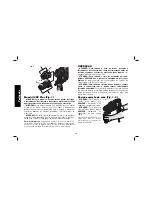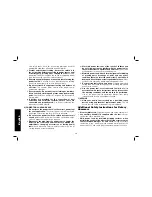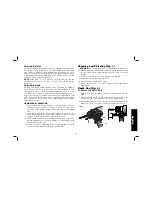
33
English
DRILLING IN METAL
An SDS Plus round shank adaptor chuck is required for metal drilling.
Ensure that tool is in drill-only mode. Start drilling with slow speed
and increase to full power while applying firm pressure on the tool. A
smooth even flow of metal chips indicates the proper drilling rate. Use
a cutting lubricant when drilling metals. The exceptions are cast iron
and brass which should be drilled dry.
NOTE:
Large (5/16" to 1/2" [7.9 mm to 12.7 mm]) holes in steel can
be made easier if a pilot hole (5/32" to 3/16" [4 mm to 4.8 mm]) is
drilled first.
DRILLING IN WOOD
An SDS Plus round shank adaptor chuck is required for drilling in
wood. Ensure that tool is in drill-only mode. Start drilling with slow
speed and increase to full power while applying firm pressure on the
tool. Holes in wood can be made with the same twist drills used for
metal. These bits may overheat unless pulled out frequently to clear
chips from the flutes. For larger holes, use spade bits, power auger
bits, or hole saws. Work that is apt to splinter should be backed up
with a block of wood.
HAMMERDRILL OPERATION
1. When drilling, use just enough force on the hammer to keep it
from bouncing excessively or “rising” off the bit. Too much force
will cause slower drilling speeds, overheating, and a lower drilling
rate.
2. Drill straight, keeping the bit at a right angle to the work. Do not
exert side pressure on the bit when drilling as this will cause
clogging of the bit flutes and a slower drilling speed.
3. When drilling deep holes, if the hammer speed starts to drop off,
pull the bit partially out of the hole with the tool still running to help
clear debris from the hole.
4. For masonry, use carbide-tipped bits or masonry bits. A smooth
even flow of dust indicates the proper drilling rate.
Chipping and Chiseling (Fig. 1)
WARNING:
Do not operate in drill or hammerdrill mode with a
chisel bit in the chuck. Personal injury and damage to tool may result.
1. Insert chisel while in hammerdrill mode and rotate to desired
position.
2. Set the mode selector (D) to the hammer-only position.
3. Adjust the side handle (H) as required.
4. Switch on the tool and start working.
5. Always switch off the tool when work is finished and before
unplugging.
Depth Rod (Fig. 6)
TO ADJUST THE DEPTH ROD
1. Push in and hold the depth rod release button (I) on the side
handle.
2. Move the depth rod (G) so the distance between the end of the
rod and the end of the bit equals the desired drilling depth.
3. Release the button to lock rod into position. When drilling with the
depth rod, stop when end of rod reaches surface of material.
FIG. 6
I
G
H






































